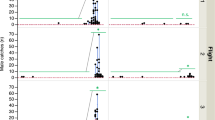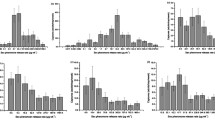Abstract
The timing and duration of approaches by male peachtree borer Synanthedon exitiosa Say (Lepidoptera: Sesiidae) to commercial pheromone dispensers placed singly or at high density in peach orchards was determined by using field-deployed video cameras and digital video recorders. Cameras were trained on one dispenser, and one standard lure was placed in a peach orchard, and on 12 dispensers in a separate orchard where dispensers for mating disruption had been placed at 371 per hectare. Male moth approaches were video recorded at the peak of peachtree borer annual flight, from 13 to 18 August 2009. The mean approach timing (h:min:sec±SD) during the study period was 11:33:12 ± 00:46:43, 11:43:52 ± 00:45:58, and 11:41:21 ± 00:45:54 AM with the single dispenser, high-density dispensers, and lure, respectively. Day-to-day variability in approach timings suggested that there were no biologically significant differences among treatments. The frequency distribution of approach durations varied among treatments, as the high-density dispensers had mostly short approaches, while the distribution of approaches to the single dispenser and lure was wider. The median (interquartile range) approach duration was 3 (2–4), 1 (1–2), and 4 (2–6) seconds with the single dispenser, high-density dispensers, and lure, respectively. The relative rank of median approach durations was constant throughout the period, indicating differences among treatments. This study showed that the presence of pheromone dispensers for mating disruption did not cause an advancement of peachtree borer diel rhythm of response. Shorter approaches to dispensers placed at high density than singly suggest that dispenser retentiveness is not constant with peachtree borer, which may bias estimates of disruption activity as a function of dispenser density.



Similar content being viewed by others
References
Barry, M. W. and Nielsen, D. G. 1984. Behavior of adult peachtree borer (Lepidoptera: Sesiidae). Ann. Entomol. Soc. Am. 77:246–250.
Bartell, R. J. 1982. Mechanisms of communication disruption by pheromones in control of Lepidoptera: A review. Physiol. Entomol. 7:353–364.
Cardé, R. T. 1990. Principles of mating disruption, pp. 47–71, in R. L. Ridgway and R. M. Silverstein (eds.). Behavior-Modifying Chemicals for Pest Management: Applications of Pheromones and Other Attractants. Marcel Dekker, New York.
Cardé, R. T. and Minks, A. K. 1995. Control of moth pests by mating disruption: Successes and constraints. Annu. Rev. Entomol. 40:559–585.
Cardé, R. T., Staten, R. T., and Mafra-Neto, A. 1998. Behavior of pink bollworm males near high-dose, point sources of pheromone in field wind tunnels: Insights into mechanisms of mating disruption. Entomol. Exp. Appl. 89:35–46.
Derksen, S., Chatterton, M., Gries, R., Aurelian, M., Judd, G., and Gries, G. 2007. Semiochemical-mediated oviposition behavior by female peachtree borer, Synanthedon exitiosa. Entomol. Exp. Appl. 123:101–108.
Eichlin, T. D., and Duckworth, W. D. 1988. Sesiodea: Sesiidae, pp 1–176, in R. B. Dominick, D. R. Davis, D. C. Ferguson, J. G. Franclemont, R. W. Hodges, E. G. Munroe and J. A. Powell. The moths of America north of Mexico, fasc. 5.1. Wedge Entomological Research Foundation, Washington D.C.
Gentry, C. R. and Wells, J. M. 1982. Evidence of an oviposition stimulant for peachtree borer. J. Chem. Ecol. 8:1125–1132.
Greenfield, M. D. and Karandinos, M. G. 1979. Resource partitioning of the sex communication channel in clearwing moths (Lepidoptera: Sesiidae) of Wisconsin. Ecol. Monogr. 49:403–426.
Mclaughlin, J., Doolittle, R., Gentry, C., Mitchell, E., and Tumlinson, J. 1976. Response to pheromone traps and disruption of pheromone communication in the lesser peachtree borer and the peachtree borer J. Chem. Ecol. 2:73–81.
Miller, J. R., Gut, L. J., de Lame, F. M., and Stelinski, L. L. 2006a. Differentiation of competitive vs. non-competitive mechanisms mediating disruption of moth sexual communication by point sources of sex pheromone (part 1): theory. J. Chem. Ecol. 32:2089–2114.
Miller, J. R., Gut, L. J., de Lame, F. M., and Stelinski, L. L. 2006b. Differentiation of competitive vs. non-competitive mechanisms mediating disruption of moth sexual communication by point sources of sex pheromone (part 2): case studies. J. Chem. Ecol. 32:2115–2143.
Miller, J. R., Mcghee, P. S., Siegert, P. Y., Adams, C. G., Huang, J., Grieshop, M. J., and Gut, L. J. 2010. General principles of attraction and competitive attraction as revealed by large-cage studies of moths responding to sex pheromone. Proc. Natl. Acad. Sci., USA 107:22–27.
Slingerland, M. V. 1899. The peach-tree borer. Cornell Univ. Agric. Exp. Stn. Bull. 176: 155–233.
Snow, J.W. 1990. Peachtree borer and lesser peachtree borer control in the United States, pp 241–253, in R. L. Ridgway and R. M. Silverstein (eds.). Behavior-Modifying Chemicals for Pest Management: Applications of Pheromones and Other Attractants. Marcel Dekker, New York.
Stelinski, L. L., Gut, L. J., Pierzchala, A. V., and Miller, J. R. 2004. Field observations quantifying attraction of four tortricid moth species to high-dosage pheromone rope dispensers in untreated and pheromone-treated apple orchards. Entomol. Exp. Appl. 113:187–196.
Teixeira, L. A. F., Miller, J. R., Epstein, D. L., and Gut, L. J. 2010. Comparison of mating disruption and mass trapping with Pyralidae and Sesiidae moths. Entomol. Exp. Appl. (in press)
Tumlinson, J. H., Yonce, C. E., Doolittle, R. E., Heath, R. R., Gentry, C. R., and Mitchell, E. R. 1974. Sex pheromones and reproductive isolation of the lesser peachtree borer and the peachtree borer. Science 185:614–616.
Acknowledgements
The authors thank K. Buhrer, M. Haas, J. Jones, and P. McGhee for technical assistance, and grower-cooperators A. and R. Bjorge for access to their orchards. This work was funded in part by grants from EPA-American Farmland Trust, Project GREEEN, and Pacific Biocontrol.
Author information
Authors and Affiliations
Corresponding author
Rights and permissions
About this article
Cite this article
Teixeira, L.A.F., Grieshop, M.J. & Gut, L.J. Effect of Pheromone Dispenser Density on Timing and Duration of Approaches by Peachtree Borer. J Chem Ecol 36, 1148–1154 (2010). https://doi.org/10.1007/s10886-010-9853-8
Received:
Revised:
Accepted:
Published:
Issue Date:
DOI: https://doi.org/10.1007/s10886-010-9853-8




